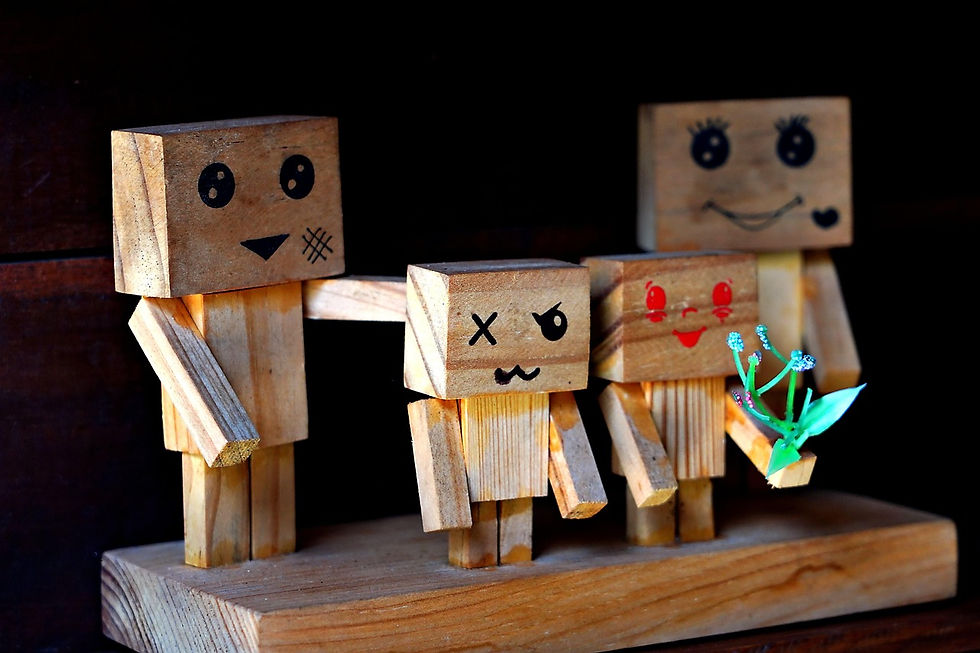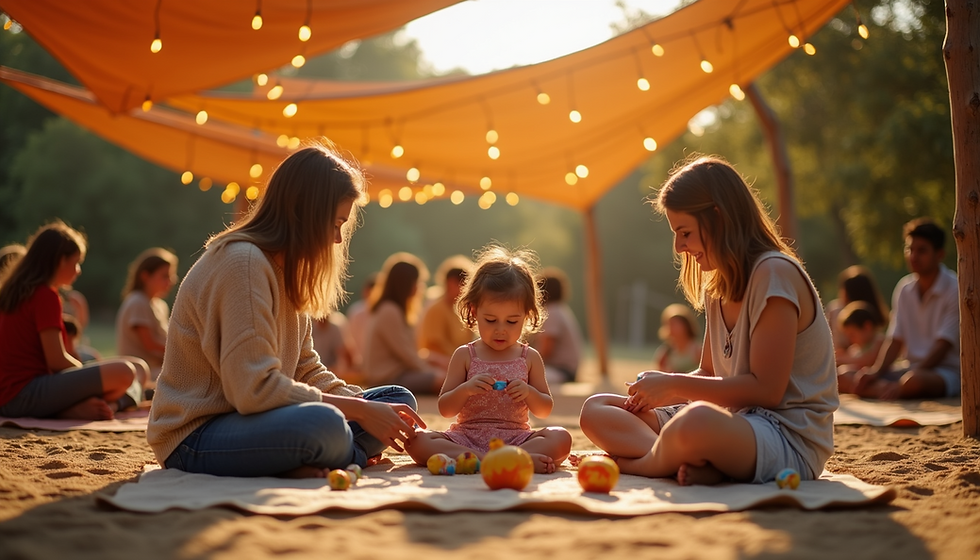Building Community Resilience Through Art and Healing Services
- Ziska Maria
- Jun 2
- 4 min read
Updated: Aug 25
On a rainy Sunday afternoon, a family gathers around the kitchen table. Paintbrushes dip into bright colors, little fingers smudge shapes onto paper, and laughter rises as a toddler’s “rainbow dragon” looks more like a spaghetti monster. Later that evening, the same family puts on a favorite song and dances barefoot in the living room. These small rituals—painting, singing, dancing—may seem simple, but research shows they are profoundly powerful for healing, connection, and resilience.

In today’s world, parents and children carry heavy layers of stress: post-pandemic fatigue, economic uncertainty, even the lingering impact of natural disasters like Hurricane Helene in Western North Carolina. Amid these pressures, families need anchors they can rely on to bring joy, regulate emotions, and foster closeness. Art, music, dance, and shared rituals provide exactly that.
Art in Community: Belonging and Healing Together
When people create art side by side, it does more than decorate walls. Community art builds resilience and social bonds. After 9/11, thousands of children contributed self-portraits to a global mural project, and art therapists observed that “artistic expression immediately alleviated the pain of a community struggling to make sense of an illogical sequence of events” (Wikipedia, 2024a).
Reviews of arts engagement consistently show benefits for mental health, reducing loneliness, and even lowering healthcare costs—up to £1,000 (~$1,300) per person per year (Daily Telegraph, 2024). Participating in collective art activities helps people feel grounded, safe, and less alone (Kumari et al., 2024). In other words, art in community is not a luxury—it is medicine.
Family Rituals: Small Acts That Anchor Us
Inside the home, art and creative rituals become dependable rhythms that children and parents can lean on. Whether it’s weekly family art night, telling stories at bedtime, or drawing together on a rainy day, these practices regulate emotions and build security.
Research shows that expressive arts activities in families enhance sibling warmth, emotional regulation, and confidence (Alaverdyan & Piranian, 2024). In families raising neurodiverse children, creative rituals foster inclusion, strengthen bonds, and expand communication (Hamm et al., 2024). Scholars argue that art-based rituals may be especially important for creating intergenerational memories of resilience (Dunkel, 2022).
The beauty lies in their simplicity: a ritual doesn’t need to be elaborate to work. Even five minutes of shared coloring, making up a story together, or singing before dinner can create a rhythm of safety and belonging.
Dance and Movement: Healing Through the Body
Sometimes words aren’t enough—especially for children. Dance and movement therapy (DMT) taps into the mind-body connection through rhythm, play, and creative expression. Studies show DMT reduces anxiety, aggression, and stress in children, while improving mood and nonverbal communication (Wikipedia, 2024b). Moving together—whether siblings twirl in circles or parents sway with their child—creates physical synchrony that deepens bonding (Tarr et al., 2015).
Even remote dance-movement sessions during COVID helped preschoolers access inner worlds through embodied play, highlighting the adaptability and healing potential of movement (Shuper Engelhard et al., 2022).
Music: A Universal Language of Bonding
Like movement, music cuts straight to the heart. From lullabies to shared drumming circles, music synchronizes our bodies and emotions. Neuroscience shows that music activates brain regions tied to memory and emotion, including the amygdala, hippocampus, and cerebellum (Kreutz et al., 2023).
Music therapy research demonstrates benefits for children with mood and anxiety disorders, enhancing self-esteem, communication, and decision-making (Wikipedia, 2024c). For families, singing and rhythm-making sessions strengthen interaction and attachment, while also building attention and motor skills (Wikipedia, 2024c).
Why It Matters for Parents, Children, and Siblings
Shared creative rituals—whether drawing, storytelling, dancing, or drumming—aren’t just fun. They are powerful tools that:
Regulate stress by lowering cortisol and increasing calm (Verywell Health, 2022).
Support brain development, enhancing social cognition, memory, and emotional awareness (Daily Telegraph, 2024).
Foster attachment by creating synchrony between parents, children, and siblings (Wikipedia, 2024b).
Build resilience by providing reliable, joyful routines during uncertain times (Dunkel, 2022).
For siblings, these activities create a shared language of play and cooperation. For parents, they offer a way to connect beyond discipline or stress. For whole communities, they generate collective hope and belonging.
A Call to Create Together
In a world that often feels fractured, picking up a paintbrush, turning up the music, or dancing in the kitchen is an act of healing. These rituals remind us that creativity is not about perfection—it’s about presence. Art, music, and movement help families and communities alike find their way back to connection, joy, and resilience.
This week, try one small ritual: a family doodle before bedtime, a three-song living-room dance party, or a community art project with neighbors. Healing doesn’t always come in grand gestures. Sometimes, it’s in the paint smudges on your kitchen table and the laughter of children spinning in circles.
References
Alaverdyan, A., & Piranian, A. (2024). Expressive arts and sibling relationships in early childhood. Early Child Development and Care. https://doi.org/10.1080/03004430.2024.2336053
Daily Telegraph. (2024, June 18). Health benefits of arts and culture. News Corporation. https://www.dailytelegraph.com.au/lifestyle/health-benefits-of-arts-and-culture/news-story/29cecba7a46efb51521cabea4d90198b
Dunkel, S. (2022). Expressive arts in intergenerational connection: A review. Lesley University Digital Commons. https://digitalcommons.lesley.edu/expressive_therapies_theses/73
Hamm, J., Stabel, A., & Dillenburger, K. (2024). Family creative activities and inclusion of children with autism spectrum disorder. Family Relations, 73(2), 299–314. https://doi.org/10.1111/fare.13092
Kreutz, G., et al. (2023). Music and the brain: Emotional and cognitive mechanisms. arXiv. https://arxiv.org/abs/2301.10914
Kumari, N., et al. (2024). AI-mediated co-creative storymaking in families. arXiv. https://arxiv.org/abs/2402.06472
Shuper Engelhard, E., et al. (2022). Dance/movement therapy with preschoolers in times of crisis: Remote prop-based embodied play. Frontiers in Psychology, 13, 9222027. https://doi.org/10.3389/fpsyg.2022.9222027
Tarr, B., Launay, J., & Dunbar, R. I. M. (2015). Silent disco: Movement synchrony and social bonding. Evolution and Human Behavior, 36(5), 452–460. https://doi.org/10.1016/j.evolhumbehav.2015.05.004
Verywell Health. (2022, August 18). Art therapy: Definition, types, techniques, and efficacy. https://www.verywellhealth.com/art-therapy-5212229
Wikipedia. (2024a). Child art. In Wikipedia. https://en.wikipedia.org/wiki/Child_art
Wikipedia. (2024b). Dance therapy. In Wikipedia. https://en.wikipedia.org/wiki/Dance_therapy
Wikipedia. (2024c). Music therapy. In Wikipedia. https://en.wikipedia.org/wiki/Music_therapy


Comments